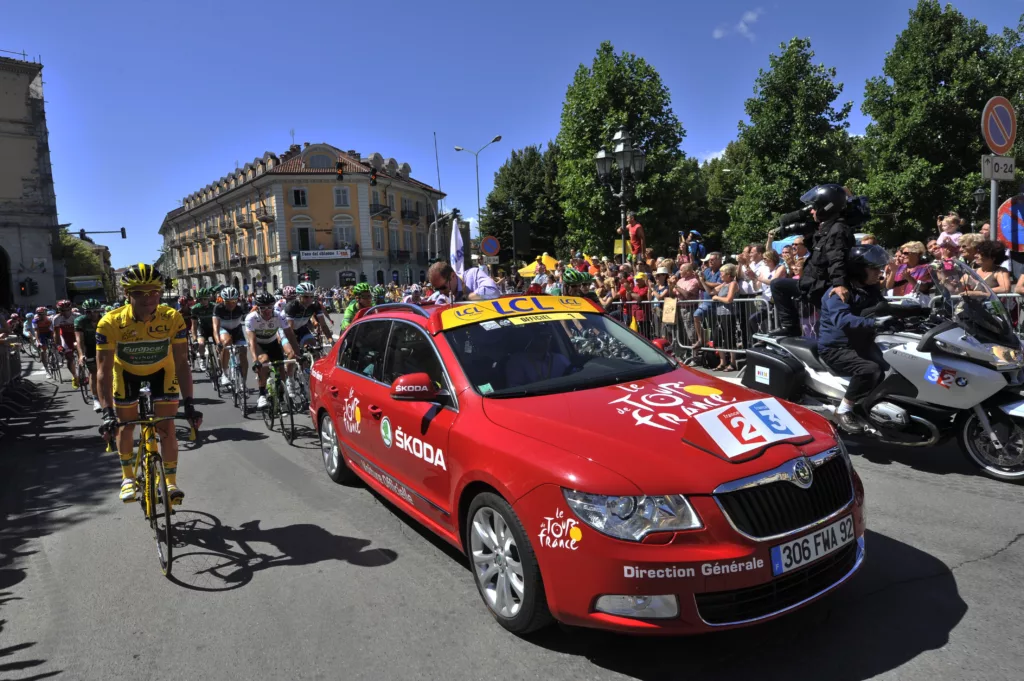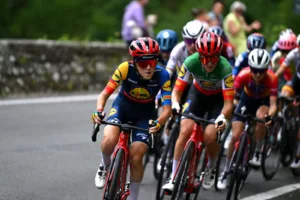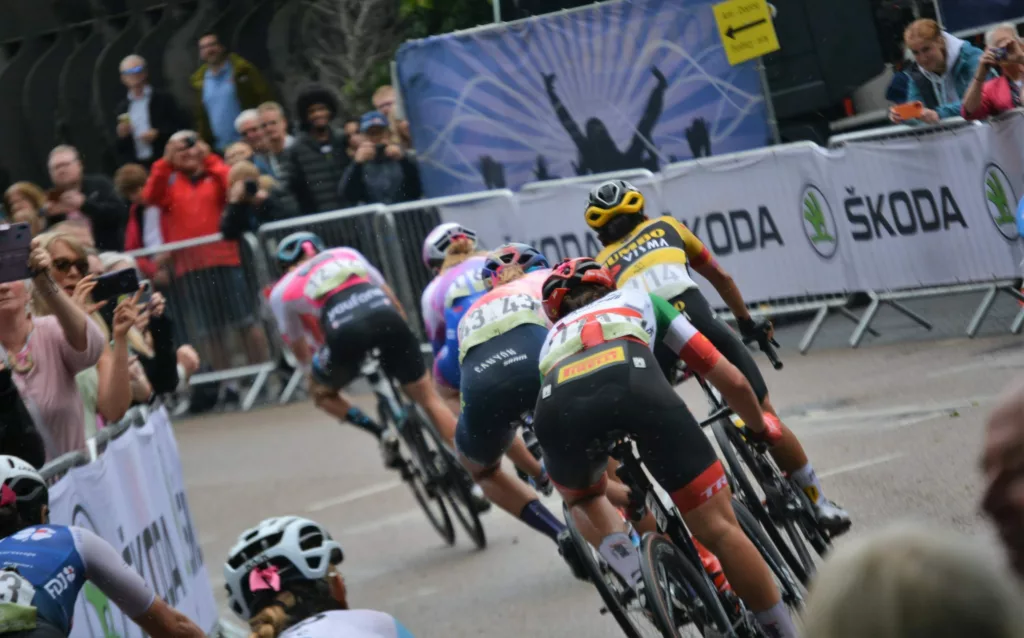Škoda has held the title of the official vehicle partner of the Tour de France since 2004 and maintains a substantial presence at the world’s premier cycling event. As the brand prepares to support cyclists, officials, and teams for the 20th time, it does so with Škoda’s most technologically advanced car to date: the fully electric Enyaq.
Table of Contents
ToggleFrom 2004 onwards, Škoda has utilised the Tour de France as the paramount exhibition for its vehicles. Beyond supplying the command car used by the race director – identified as Direction Generale car number 1 – the brand also furnishes over 200 support vehicles for members of the organising team and event management. Nevertheless, it’s the race director’s car that most spectators will identify due to its prominent role at the forefront of the action. This vehicle, colloquially referred to as the ‘red car’ within Tour de France circles, serves essentially as the race director’s office and operates as a communications centre through which race officials and management teams can oversee and control the race.
In total, Škoda race direction cars have kick-started 399 stages and journeyed more than 41,000 miles since Škoda began its partnership with the Tour de France. By the conclusion of this year’s event, the tally will have reached 420 stages.
Superb Mk1 (2004 – 2007)
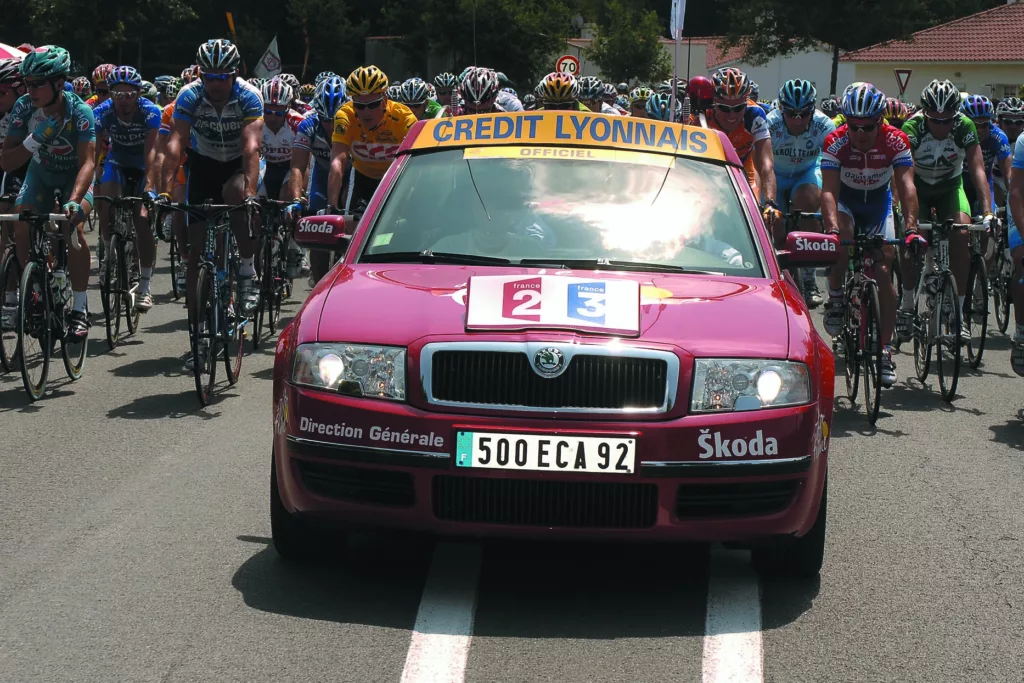
In 2004, Škoda stepped into the role of the official vehicle partner to the Tour, taking over from Alfa Romeo. The brand opted for the Superb as the race director’s car, which, with its extended wheelbase and limousine-like rear legroom, turned out to be the perfect car for Jean-Marie Leblanc, the Director of the Tour de France, to oversee the event. The first-generation Superb, like all race director vehicles, was equipped with a number of special features added by Škoda. These encompassed a rear sunroof that allowed race director Leblanc to stand, along with a set of roof rails custom-built to align with the curvature of the Superb roof. The first-generation Superb also exhibited a number of more peculiar features requested by the management team, including a makeshift desk and a compact, air-conditioned centre console designed to store a bottle of Champagne and two glasses.
Dressed in Corrida red and originally driven by a 130PS 1.9 TDI four-cylinder engine, the first-generation Superb remained in service until 2008, with a revamped model replacing the original in 2006. That same year, Christian Prudhomme took over from Jean-Marie Leblanc as the Director of the Tour de France.
Superb Mk2 (2008 – 2015)
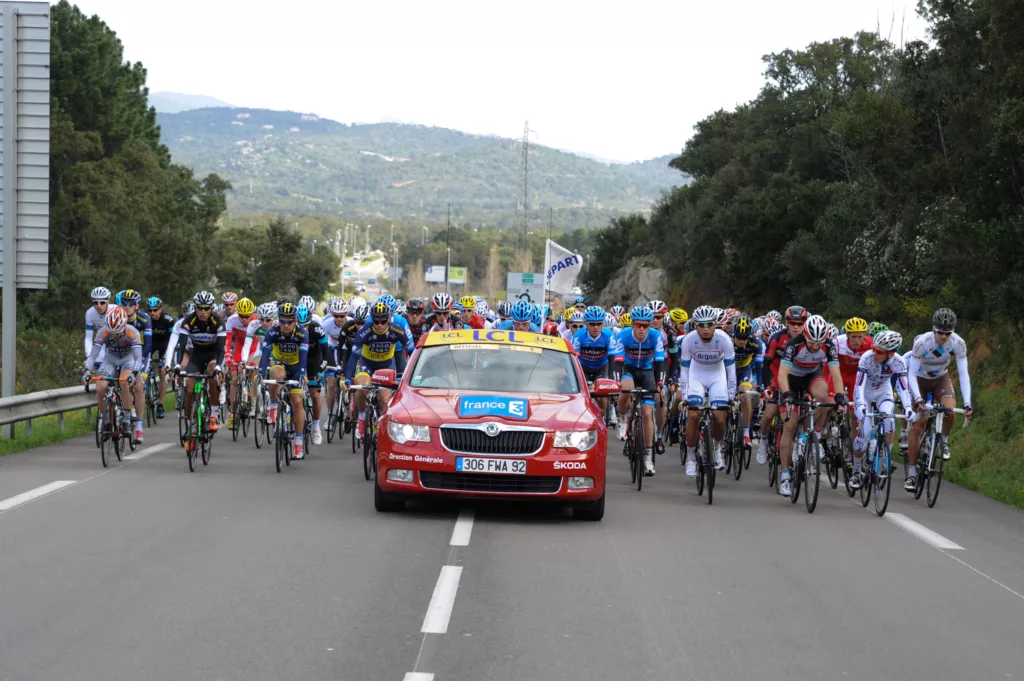
Introduced at the Geneva Motor Show in March 2008, the second-generation Superb made its debut at the 95th Tour de France in Brest merely three months afterwards. Entirely revamped, the 2008 Superb incorporated numerous new attributes, with the most remarkable being a unique ‘twin door’ boot lid, which could operate as a tailgate or a saloon-style boot with just a button press.
The second iteration of the Superb also provided even more legroom in the rear than its predecessor, enabling the event organisers to equip a larger centre console, an enhanced GPS system, and a workspace for race director Christian Prudhomme. Consistent with tradition, the Superb kept the Champagne chiller and glasses, and included several custom-made additions. These encompassed roof rails fused with front and rear wind deflectors, along with an enlarged, rear-positioned glass sunroof.
Like the original Superb, the second-generation model also served as a hospitality venue for the race director. Prudhomme always maintained his usual place behind the driver, while the additional rear passenger seat was frequently kept for celebrities, VIPs, and dignitaries. Over the past decade, the ‘extra’ seat has accommodated sporting legends, actors, and French presidents including Tom Cruise, Ben Stiller, Connor McGregor, Prince Albert of Monaco, and Nicolas Sarkozy.
“Škoda is an important partner of the Tour de France and the Škoda car number 1 is my office for each stage. The car is a sort of control tower that receives all the information of what is happening on the race route before the arrival of the riders (demonstrations, potential blockage, road and weather conditions). Over the course of the 3,500 km race I can spend anywhere between two to nine hours in the car number 1 each day. Needless to say I do spend a large portion of the month of July in the back seat of a Škoda.”
Christian Prudhomme, Director of the Tour de France
Superb Mk3 (2016 – 2019)
In 2016, Škoda unveiled the third iteration of the Superb. Much like its predecessors, this model afforded race director Christian Prudhomme a more spacious interior, an expanded workspace, and superior comfort for lengthy trips. For that year, Škoda produced a 2.0 TDI four-cylinder model boasting 190PS and a six-speed DSG gearbox.
The Tour de France organising team customised this model with a state-of-the-art GPS and a communication hub, providing Prudhomme with an unparalleled amount of information. For instance, the radio system in this third-generation vehicle came equipped with four channels. One was the ‘Radio Tour’ channel offering a comprehensive view of the entire peloton, another was the ‘Info’ channel conveying information about the route, and the remaining two were private channels reserved strictly for managers and commissioners.
In terms of design, the 2016 Superb retained the same layout as its forebears. Prudhomme’s ‘office seat’ was situated behind the driver, complete with a sizeable glass sunroof at the rear to allow him to stand and observe the riders.
Superb iV Mk3 (2020 – present)
Unveiled the year before, the Superb iV emerged as the optimal selection to cater to the event’s race director from 2020, due to its capability to operate without producing any tailpipe emissions.
Armed with Škoda’s inaugural plug-in hybrid propulsion system, the Superb iV was the focal point of the 2020 event and has been employed at all following events. Gilles Maignan, a former cyclist who is now the driver of the race director’s car, shared that the transition to hybrid power has been well-embraced by both the event organising team and the riders.
Capable of covering up to 34 miles solely on electric power, the Superb iV is used in partnership with the new Enyaq. It boasts the same adjustments as the non-hybrid model it superseded and is deployed during the race’s more prolonged stages. It is also the first Škoda model that does not rely on diesel to be utilised for the Direction Generale car, courtesy of its 1.4-litre TSI petrol engine that functions in unison with the plug-in hybrid’s 85kW electric motor.
Enyaq (2020 – present)
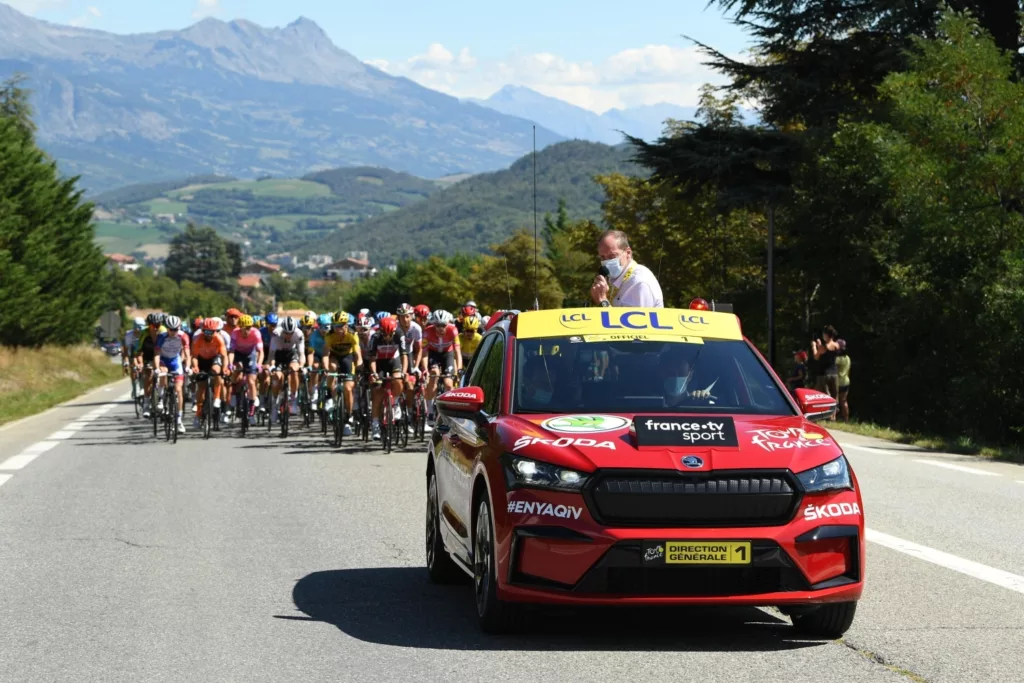
In 2020, Škoda unveiled the first fully-electric ‘red car’ at the Tour de France, known as the Enyaq. This first-ever purpose-built electric car from the brand made its initial appearance at the fifth stage of the event (Gap to Privas), before being utilised on two additional stages later in the race.
The transformation from a standard Enyaq SportLine to the Tour de France race director’s car was undertaken by prototype creators Best Modell, under the guidance of Škoda engineers. As part of this makeover, a sunroof was fitted above the rear seats, while the standard roof bars were heightened for ease of grip when the car was moving.
The conversion team was also tasked with designing and procuring a new centre console and cooling cabinet for the traditional bottle of champagne. To guarantee that the vehicle’s supplementary equipment didn’t compromise the Enyaq’s driving range, the team integrated two 75 ampere batteries into the boot floor. The design was finalised with new champagne flute holders, conceptualised and 3D printed in-house by Best Modell.
In addition to the body alterations, the Enyaq incorporates a number of attributes that enhance its environmental footprint. Among these are unique tyres devised by Continental (a partner of the Tour de France itself) specifically for the Enyaq. Employed on all Enyaq support models during the event, these special tyres boast carcasses made entirely from recycled PET materials.
Following its successful debut in 2020 on three selected stages, the Tour de France organising team decided to appoint the Enyaq as the primary race direction vehicle for 2021. It has since served as the main Direction Generale car for the event, with the Superb iV being deployed for some mountain stages. In 2022, the Enyaq assumed the role of the command vehicle for 16 out of the 21 stages.
| 2004 Red Car – Škoda Superb Gen I | 2023 Red Car – Škoda Enyaq iV |
| Diesel | Electric |
| Manual transmission | Automatic transmission |
| 140 PS | 201 PS |
| 9.9s 0-62mph | 8.5s 0-62mph |
| 134 mph top speed | 99 mph top speed |
Škoda’s commitment to the Tour de France extends beyond the high-profile command car seen leading the peloton. As the official main vehicle partner, it supplies 200 vehicles to the organisers and race management, as well as service and support vehicles. Alongside the Enyaq, the fleet also includes the Octavia and Superb models.
The brand, which started life as a small bicycle workshop in 1895, has also designed the crystal trophy for the winner for the past 12 years and has sponsored the green jersey for the leader of the points standings since 2015.
Q&A with Christian Prudhomme, Director of the Tour de France
How important is the role of the lead car to ensure the race runs smoothly?
Each car has a vital role in the smooth running of the race. Whether it be a Director or a Commissaire car, everyone plays their role to ensure the safe running of the Tour de France for all the parties involved. Car number 1 is a sort of control tower that receives all the information of what is happening on the race route before the arrival of the riders.
How do you work with Škoda to improve the car to support you in your role?
Škoda is an important partner and plays a key and obvious role in the organisation of the Tour de France due to the fact that it is an event where we are almost constantly on the move. We ensure to collect our feedback and share it with Škoda so they can best adapt (if needed) their vehicles for the very specific usage that we have on the Tour de France.
Q&A with Gilles Maignan, Driver of Race Direction Car Number 1
The Race Direction Car Number 1 is driven by two-time French time trial champion, Gilles Maignan. Maignan retired from the sport in 2001 and was asked by Christian Prudhomme to be his driver after he had previously driven him in a VIP car during Prudhomme’s days working for French TV.
In order to take this important role within the race, Maignan first had to obtain an FCC driving license and is required to attend training sessions specific to driving in the Tour de France. Professional cyclists are often recruited to drive inside the race as they know how to anticipate and react according to the movements of the cyclists and peloton. Each year the lead car driver schedules debrief sessions with Škoda to share feedback gathered from all Tour drivers to help improve the vehicles for future Tours.
What are the best car developments over the years that have benefited you?
The switch to automatic gearboxes has really simplified the driving from inside a cycling race, especially for uphill portions. Also, the dashboard on the Superb shows exactly how many kilometres you have driven to the first decimal, which is very important in a cycling race to know how far you are from the finish. We have recently switched to hybrid vehicles which allows me to be in electric mode between the Fictive Start and Real Start of each stage, which is appreciated by the riders who have to stay right behind me on this section.
How does it feel to lead the peloton?
It changes a bit from back when I was a rider. I have an important responsibility to lead out the best riders on the biggest professional cycling race in the world and my job is to help Christian Prudhomme ensure a safe race for everyone, including the spectators.
How do the cars communicate with each other and how has it changed?
This is done through radio communication as it has proven to be the most effective and direct way to communicate, especially when you reach some very remote areas of France where telephone signal can be scarce.
Are there any speed limits that need to be adhered to?
Yes, we cannot go over 50 mph (80 km/h) except for the downhills if a rider is catching up to me. However, the main rule imposed by the UCI is that we cannot go over 12mph (20km/h) faster than the speed of riders.


